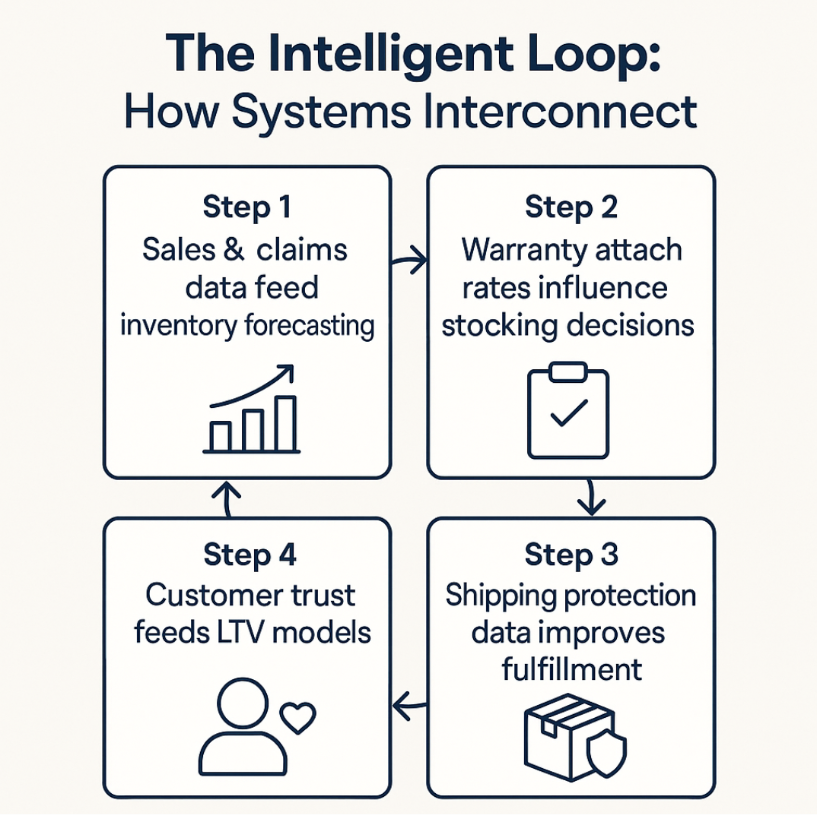



“In the long history of humankind… those who learned to collaborate and improvise most effectively have prevailed.” – Charles Darwin
Let me rewrite Darwin’s wisdom for modern e-commerce (because why should biologists have all the fun?)
“In the long history of e-commerce, it’s not the biggest catalog or the lowest price that wins, it’s the merchants whose systems collaborate and adapt in real time.”
Feels obvious, until you realize how few are actually doing it. Isn’t it?”
Because here’s the thing, most merchants already have decent inventory tools, and some form of warranty or shipping protection. But they’re running in separate lanes.
Confused? Let me make this clear-
Let’s say it’s the week after Christmas. Your best-selling coffee maker, the one you moved hundreds of units of during your holiday promo, starts racking up warranty claims for a faulty heating element.
The warranty platform approves replacements within hours, but your inventory tool isn’t seeing that data in real time. On paper, it just looks like you’re selling more. So you keep ordering stock with known defects, thinking you’re chasing demand. A week later, you’re out of your remaining good units, the claims are still rolling in, and you’re stuck telling loyal customers their replacement is weeks away. The data was there, it just wasn’t connected in a way that could prevent the problem.
And this isn’t rare. In 2024, the estimated return rate for e-commerce orders hit 20.4%. Pair that with the fact that 70–90% of stockouts are caused by poor replenishment decisions not by actual product shortages.
While that stat comes from the broader inventory world, the same pattern can happen with claims management: if replacement orders or product failure trends aren’t feeding into the system that drives stocking decisions, gaps open up fast.
For a small or mid-sized merchant, a few dozen replacement orders slipping through the cracks isn’t just a minor hiccup, it can wipe out a month’s profit and damage customer loyalty. Larger players might absorb the hit; SMEs can’t.
That’s the gap we’re talking about here.
When inventory, warranty, and shipping protection actually work together in one loop, you cut stockouts, bump up attach-rate revenue, and give customers a reason to come back for more.
boAt (Electronics Brand)
Boat, one of the world’s largest wearable electronics brands, used a digital platform to align warranty claims and inventory tracking across 12,000 SKUs and 108 locations. This cut incorrect warranty claims, accounting for 4% of annual revenue loss, while bringing precise, location-specific inventory visibility to their planning process.
Furniture Retailers (via SureBright)
High-value furniture sellers like North End Furniture and Dreamee Home saw warranty attach rates increase to 52% when offering protection plans through SureBright. That wasn't just revenue they were turning doubters into loyal repeat buyers because customers finally felt confident buying big-ticket item
So, let’s start talking about,

Inventory tools are great at telling you “We have 112 units left” or “this SKU will run out in 13 days.” What they don’t tell you is why a product is moving faster (or slower) than expected or maybe whether those movements are tied to product issues, replacements, or shipping damage.
That’s the blind spot. If your system sees 30 extra sales, it assumes demand went up, but what if 20 of those were warranty replacements? You might reorder thinking it’s a hot seller, when really, you’re just backfilling defects.
Common misses can be:
Inventory management systems are great, no doubt about it. But with warranty and claims data, they can be even better like forecasting replacement demand, spotting defect trends early, optimizing reorder timing, and ensuring the right stock is always ready for customers who need it the most.
Warranty programs are great, they process claims, approve replacements, and keep customers happy when something goes wrong. But when they run in isolation, they miss the chance to strengthen the rest of your business.
Common misses can be:
Warranty programs can protect customers. But with operational hooks into inventory and fulfillment, they can also protect your margins, stock levels, and forecasting accuracy.
How it works: Sales data from your order management system pairs with claims data from your warranty platform. Your demand forecasting tool adjusts stock levels based on both new sales and replacement demand, while also flagging product defect trends before they escalate.
Scenario: After your holiday promo, sales for your best-selling coffee maker surge. Two weeks later, your warranty platform starts logging multiple claims for a faulty heating element.
Because your order management system and warranty platform are integrated with your forecasting tool, the system automatically detects the spike and flags it as unusual.
It recommends reducing the next reorder to avoid piling up defective units and suggests triggering a supplier quality check. You review the alert, approve the action, and within days, you can stop hundreds of faulty products from leaving the warehouse, protecting customers and preventing a costly headache.
How the tools are used:
How it works: Attach rate data from your warranty platform flows into your merchandising and inventory planning systems. High attach rates signal higher perceived value or risk, which informs how much stock to carry, where to position it, and how to price it.
Scenario: Let’s say your warranty platform shows a 38% attach rate for the coffee maker, much higher than anything else in the kitchen appliance category.
That data flows into your merchandising and inventory planning systems, which flag the coffee maker as a hero SKU. The inventory management tool recommends increasing safety stock and shifting units closer to high-demand regions so you can fulfill both sales and warranty replacements without delay.
You greenlight the update, making sure you’re ready for continued demand.
How the tools are used:
And hey! You know with, SureBright’s AI-powered extended product protection platform, merchants see 20%+ attach rates and 16.3% higher retention on average.
Want to see what that could look like for your store? You can calculate how much money you can earn by offering warranties in just 45 seconds, take a look.
How it works: Shipping protection claims capture details like carrier, route, and packaging type. Your fulfillment system uses this data to improve packaging, reroute shipments, or switch carriers only where needed, reducing damage without adding unnecessary costs.
Scenario: Your shipping protection platform reveals a trend and the coffee makers shipped on specific long-haul routes with a certain carrier are more likely to arrive damaged.
Your fulfillment system connects the dots, identifies the affected routes, and recommends reinforced packaging for those lanes. It also suggests switching carriers for a portion of shipments. You approve the changes, and within weeks, damage claims for that route drop by nearly, let’s say 20%, cutting replacement costs and improving delivery satisfaction.
How the tools are used:
How it works: Post-claim satisfaction scores from your warranty platform flow into your CRM and marketing automation systems. High-satisfaction customers are flagged for targeted re-engagement campaigns that can drive repeat purchases and higher lifetime value.
Scenario: One customer’s coffee maker arrives damaged, but the claim is approved within hours, and a replacement is shipped the same day.
Your CRM captures the quick resolution and tags the customer as a “service win.” The marketing automation tool then recommends sending a personalized accessory offer two weeks later. You approve the campaign, and the high chance of customer making the purchase. That’s a direct boost to lifetime value, driven by a fast, well-handled claim.
How the tools are used:

When inventory, warranty, and shipping protection are connected, you stop reacting and start anticipating.
Your customers don’t care how your systems work, they care how you make them feel when things go right or wrong.
So,
Henry Ford once said, “Coming together is a beginning, staying together is progress, and working together is success.”
In e-commerce, “working together” doesn’t just apply to teams, it applies to your systems. Inventory, warranty, and shipping protection on their own can each do a decent job, but when they work together, they create something far better than the sum of their parts.
In the end, isn’t it all about running a business that sees problems before they happen, solves them before customers notice, and turns every interaction into a reason to come back?